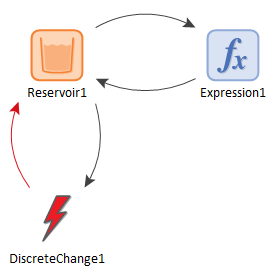
When you build a model, GoldSim automatically sequences the elements in the order that they must be computed. For example if A was a function of B, and B was a function of C, C would be sequenced first, followed by B, followed by A. This is referred to as the causality sequence. In this simple example, the sequence is obvious, but for complex models with looping logic the causality sequence may not be readily apparent.
In most cases, you do not need to be concerned with how GoldSim sequences the elements. However, in some cases (particularly when simulating systems that include discrete changes and looping logic), expert users may need to understand or manipulate the causality sequence. (The causality sequence can be viewed by selecting Model|Causality Sequence from the main menu.)
Problems arise when simulating looping systems and/or systems with discrete changes because in these cases the appropriate order of the calculations can be ambiguous. A simple example is shown below:

For this model, in what order should the elements be calculated?
For these situations, GoldSim provides some special tools to force the sequencing to occur in a particular order.
Learn more about:
Understanding the Causality Sequence
Addressing Ambiguous Causality Sequences